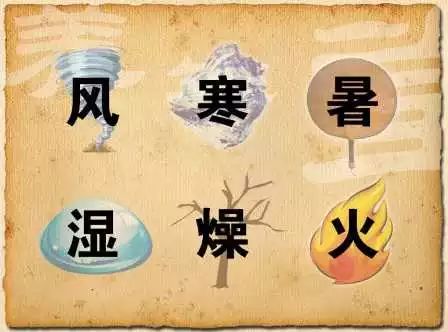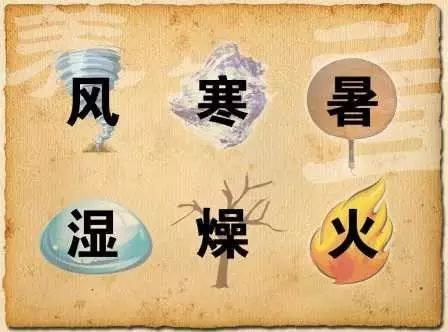
Differentiation of disease causes is a method based on the theory of disease causation in Traditional Chinese Medicine (TCM), which identifies the factors causing diseases through the analysis of clinical data.
The main content of differentiation of disease causes can be summarized into four aspects: the Six Excesses (Liù Yín 六淫), Seven Emotions (Qīng Qíng 七情), Diet and Lifestyle (Yǐn Shí Láo Yì 饮食劳逸), and External Injuries (Wài Zhuāng 外伤). Among these, the Six Excesses and Epidemic Syndromes (Yì Lì 疫疠) are classified as external pathogenic factors that cause diseases when the human body is affected by natural environmental factors. The Seven Emotions are internal pathogenic factors that often lead to disharmony in the Qi mechanism, resulting in illness. Diet and lifestyle can affect the functions of the internal organs, leading to disease. External injuries refer to pathological changes caused by external forces acting on the body.

The Six Excesses include Wind (Fēng 风), Cold (Hán 寒), Heat (Shǔ 暑), Dampness (Shī 湿), Dryness (Zào 燥), and Fire (Huǒ 火), which are external pathogenic Qi. The characteristics of diseases caused by the Six Excesses are: first, they are related to the seasons and living environment; for example, in summer, there are many cases of heat-related illnesses; prolonged exposure to damp environments can lead to dampness-related diseases. Second, the Six Excesses are external pathogens that often invade the body through the mouth, nose, and skin, leading to initial symptoms of exterior conditions. Third, the Six Excesses often combine to cause disease, and during the progression of the illness, they can influence or transform into one another.
Epidemic Syndromes are a special type of pathogenic factor in nature, characterized by strong infectivity and rapid spread.
1. Wind Excess Syndrome (Fēng Yín Zhèng Hòu 风淫证候)
Wind syndrome refers to a category of diseases caused by the invasion of Wind pathogens. Since Wind is the leader of all diseases, its nature is light and dispersive, capable of rapid changes, thus it is characterized by sudden onset, quick resolution, and erratic symptoms.
【Clinical Manifestations】 Fever with aversion to Wind, headache, sweating, cough, nasal congestion with runny nose. The tongue has a thin white coating, and the pulse is floating and slow, or there may be numbness in the limbs and face, facial droop, stiff neck, limb spasms, or skin itching.
【Syndrome Analysis】 Wind pathogens invade the exterior, harming the defensive Qi, causing the pores to open and close abnormally, hence the symptoms of fever with aversion to Wind, headache, and sweating. Wind invades the lungs, disrupting the liver Qi, leading to cough and nasal congestion. The floating and slow pulse, along with the thin white coating, indicates the invasion of Wind into the defensive Qi. When Wind invades the meridians, it causes Qi stagnation, leading to numbness, facial droop, stiffness, and spasms. When Wind affects the skin, it results in itching.
2. Cold Excess Syndrome (Hán Yín Zhèng Hòu 寒淫证候)
Cold syndrome refers to a category of diseases caused by the invasion of Cold pathogens. Cold is a Yin pathogen, characterized by its cold and constricting nature, which can easily harm Yang Qi and obstruct the flow of Qi and blood.
【Clinical Manifestations】 Aversion to cold with fever, no sweating, headache, body aches, wheezing cough, nasal congestion, thin white coating on the tongue, and a tight floating pulse. There may also be stiffness in the hands and feet, cold limbs, weak pulse, or abdominal pain with borborygmi, diarrhea, and vomiting.
【Syndrome Analysis】 Cold pathogens bind the exterior, causing cold and constriction, leading to obstruction of the defensive Yang Qi, hence the symptoms of fever with aversion to cold and no sweating. Cold pathogens stagnate in the meridians, causing headache and body aches. The lungs are associated with the skin, and when the skin is affected, it leads to wheezing and nasal congestion. The tight floating pulse and thin white coating indicate the exterior invasion of Cold. If Cold pathogens stagnate in the meridians and harm Yang Qi, it leads to stiffness in the limbs; if Cold obstructs the flow of Qi, it results in cold limbs; if Cold constricts, it can lead to a weak pulse. If Cold penetrates internally, harming the Yang of the spleen and stomach, it disrupts the normal ascending and descending functions, leading to abdominal pain, borborygmi, vomiting, and diarrhea.
3. Heat Excess Syndrome (Shǔ Yín Zhèng Hòu 暑淫证候)
Heat syndrome refers to a category of diseases caused by the invasion of Heat pathogens in summer. Heat is characterized by its hot and dispersive nature, leading to heat symptoms, easily consuming Qi and injuring fluids, and often associated with Dampness.
【Clinical Manifestations】 Heat injury, feeling hot, sweating, thirst, fatigue, yellow urine, red tongue, white or yellow coating, and a weak rapid pulse. Heat stroke may present with high fever, sudden fainting, continuous sweating, thirst, shortness of breath, and even coma or convulsions, with a dry and red tongue and a rapid pulse.
【Syndrome Analysis】 Heat injury occurs due to the invasion of Heat and Dampness, leading to excessive sweating and consumption of fluids. The hot nature of Heat causes the body to feel hot, excessive sweating, and thirst, with yellow urine; excessive sweating leads to fatigue and a weak rapid pulse; when Heat is combined with Dampness, it can lead to a white or yellow coating. In cases of heat stroke, prolonged exposure to the sun leads to heat accumulation, disturbing the mind, resulting in sudden fainting. The heat damages fluids, leading to thirst, sweating, and shortness of breath; if the heat is severe, it can lead to dryness of the tongue and a rapid pulse.
4. Dampness Excess Syndrome (Shī Yín Zhèng Hòu 湿淫证候)
Dampness syndrome refers to a category of diseases caused by the invasion of Dampness pathogens. Dampness is heavy and sticky, easily obstructing the flow of Qi and injuring Yang Qi, leading to lingering and difficult-to-treat conditions.
【Clinical Manifestations】 Dampness injury leads to head heaviness and pain, chest tightness, no thirst, body heaviness and pain, fever with fatigue, clear and long urine, white slippery coating on the tongue, and a weak or slow pulse. When Dampness invades, it can cause a feeling of heaviness all over, with weak pulse, and if it affects the joints, it can lead to joint pain and difficulty in movement.
【Syndrome Analysis】 Dampness injury occurs when Dampness pathogens invade the exterior, often during rainy seasons, leading to initial symptoms of exterior Dampness syndrome. The heavy and sticky nature of Dampness obstructs the flow of Qi, leading to symptoms such as head heaviness and pain, chest tightness, fatigue, and body heaviness. Dampness competes with the defensive Qi, leading to fever and sweating without resolution. As Dampness is a Yin pathogen, it does not harm fluids, hence no thirst. Clear and long urine, white slippery coating on the tongue, and a weak or slow pulse indicate the presence of Dampness.
When Dampness invades the head, it can cause a feeling of heaviness, and when it pervades the body, it can lead to discomfort all over. Weak pulse is also a sign of Dampness obstruction. When Dampness invades the joints, it can lead to pain and difficulty in movement, clinically referred to as “Bi Syndrome” (Zhuó Bì 着痹).
5. Dryness Excess Syndrome (Zào Yín Zhèng Hòu 燥淫证候)
Dryness syndrome refers to a category of diseases caused by the invasion of Dryness pathogens. Dryness is characterized by its dry nature, which can easily injure fluids, and can be classified into Cool Dryness and Warm Dryness.
【Clinical Manifestations】 Cool Dryness presents with severe aversion to cold, mild fever, headache, no sweating, cough, throat itchiness, nasal congestion, dry white tongue, and a floating pulse. Warm Dryness presents with body heat, mild aversion to Wind and Cold, headache with little sweating, thirst, irritability, dry cough with little phlegm, and even blood-streaked phlegm, with dry skin and nasal passages, dry tongue with yellow coating, and a rapid pulse.
【Syndrome Analysis】 Cool Dryness often occurs in late autumn when the weather turns cool, and Dryness combines with Cold to cause illness. Dryness and Cold invade the lung’s defensive Qi, leading to symptoms similar to exterior Wind-Cold syndrome, along with cough, nasal congestion, throat itchiness, dry tongue, and floating pulse. Warm Dryness occurs in early autumn when the weather is still hot, and the lingering heat causes dryness, leading to symptoms similar to Wind-Heat syndrome, along with dry cough, little phlegm, dry skin, and irritability. A dry tongue with yellow coating and a rapid pulse indicate the presence of Dryness Heat.
6. Fire Excess Syndrome (Huǒ Yín Zhèng Hòu 火淫征候)
Fire syndrome refers to a broad category of diseases caused by Fire and Heat pathogens. Fire is characterized by its burning and urgent nature, often presenting with significant heat symptoms throughout the body or locally, easily consuming Yin fluids and causing dryness, leading to internal wind and bleeding.
【Clinical Manifestations】 High fever, thirst, red face and eyes, irritability, sweating, or agitation and delirium, nosebleeds, vomiting blood, rashes, or manic behavior, or the presence of abscesses, with a red tongue and a rapid or thin pulse.
【Syndrome Analysis】 Fire and Heat pathogens invade the Qi level, leading to high fever, thirst, red face and eyes, and a rapid pulse. If the pathogenic Qi does not resolve at the Qi level and enters the blood level, it can lead to bleeding, rashes, and skin lesions. Excessive Fire can disturb the heart and liver, leading to agitation and delirium. If Fire toxins accumulate between the flesh and blood, they can lead to abscesses. A red tongue and rapid pulse indicate the presence of Fire and Heat penetrating the blood level.
7. Epidemic Syndromes (Yì Lì Zhèng Hòu 疫疠证候)
Epidemic Syndromes, also known as Warm Diseases, refer to infectious diseases caused by epidemic viruses. One characteristic of epidemic diseases is the presence of a specific source and transmission route. The sources of infection can be twofold: one is the natural environment, transmitted through the air; the other is person-to-person transmission through contact, with transmission routes through the respiratory and digestive tracts. Another characteristic of epidemic diseases is their strong infectivity and high mortality rate.
【Clinical Manifestations】 At the onset of the disease, there is a significant aversion to cold and fever, followed by high fever, body aches, red face or dirtiness, thirst, sweating, irritability, and in severe cases, confusion and delirium, limb spasms, red tongue, thick yellow or dry white coating, and a rapid and strong pulse.
If there is swelling and pain in the head and neck, it may indicate a severe epidemic. If there is fever, swollen and ulcerated throat, and widespread scarlet rashes, it may indicate a severe throat infection. If there is throat swelling with a white membrane, hoarseness, and difficulty swallowing and breathing, it may indicate an epidemic throat infection. If there is a significant aversion to cold and fever, followed by spasmodic cough, cyanosis of the face, tears, vomiting, and a characteristic barking cough, it is often seen in children and is referred to as epidemic cough, also known as “whooping cough” (Dùn Kè 顿咳). If there is abdominal pain, diarrhea with red and white pus and blood, and a feeling of urgency, it may indicate epidemic dysentery.
【Syndrome Analysis】 The epidemic pathogen enters through the mouth and nose, or hides within the membranes, leading to initial symptoms of significant aversion to cold and fever. The epidemic toxin rapidly spreads through the three burners, leading to high fever and body aches. If the epidemic toxin attacks upward, it can cause a red face and red tongue. If the epidemic toxin accumulates on the tongue, it can lead to a white coating resembling powder and a dirty complexion. If the heat is severe, it can lead to excessive sweating. If the heat disturbs the mind, it can lead to irritability and confusion. If the heat generates wind, it can lead to limb spasms.
If the epidemic toxin obstructs the Shaoyang Gallbladder meridian, it can lead to Qi and blood stagnation in the local area, resulting in swelling and pain in the head and neck, and severe throat pain. If the epidemic toxin obstructs the lungs and stomach, it can lead to throat swelling and ulceration, with a bright red tongue. If the epidemic toxin invades the skin, it can lead to widespread scarlet rashes. If the dryness and heat of the epidemic toxin enter through the mouth and nose, it can lead to throat swelling with a white membrane, which cannot be wiped away; if the white membrane covers the airway, it can lead to hoarseness, difficulty swallowing, and breathing. If there is internal phlegm and the epidemic pathogen invades, it can lead to a deep-seated phlegm condition in the lungs, causing paroxysmal spasmodic cough. Severe coughing can lead to cyanosis of the face, tears, and vomiting. If there is unclean food, damp-heat epidemic toxins can invade the stomach and intestines, obstructing Qi flow, burning Qi and blood, leading to abdominal pain, urgency, and diarrhea with red and white pus and blood.
Related Articles
-
TCM Differentiation of Symptoms
-
Exterior and Interior Differentiation
-
Cold and Heat Differentiation
-
Deficiency and Excess Differentiation
-
Yin and Yang Differentiation
-
Overall Observation
-
Local Observation
-
Tongue Observation
-
Observation of Excretions
-
Observation of Children’s Fingerprints
-
Olfactory Diagnosis: Listening to Sounds
-
Olfactory Diagnosis: Smelling Odors
-
Inquiry Diagnosis
-
Pulse Classification and Main Diseases



